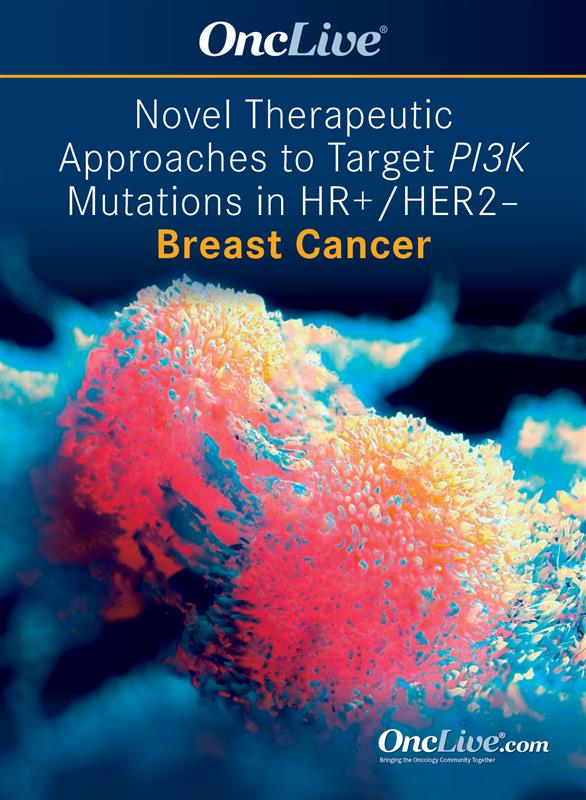Publication
Article
Supplements and Featured Publications
RLY-2608 Shows Broad Therapeutic Potential in PIK3CA-Mutant Solid Tumors
Author(s):
RLY-2608 led to sustained target inhibition with minimal effect on glucose homeostasis, acceptable safety, and antitumor activity in patients with PIK3CA-mutant solid tumors, according to interim data from the dose-escalation portion of the first-in-human phase 1 ReDiscover trial.
Andreas Varkaris, MD, PhD

RLY-2608 led to sustained target inhibition with minimal effect on glucose homeostasis, acceptable safety, and antitumor activity in patients with PIK3CA-mutant solid tumors, according to interim data from the dose-escalation portion of the first-in-human phase 1 ReDiscover trial (NCT05216432).1
Data presented at the 2023 AACR Annual Meeting showed that the PI3Kα inhibitor had antitumor activity in patients with hormone receptor (HR)–positive/HER2-negative breast cancer across PIK3CA genotypes. Of 16 patients with breast cancer and measurable disease, 56% (n = 9) experienced radiographic tumor reduction, and 81% (n = 13) achieved stable disease (SD) or partial response (PR). Moreover, RLY-2608 had a differentiated and favorable toxicity profile, with most toxicities being low grade and manageable.
As of March 2023, dose escalation was ongoing in both arms. No dose-limiting toxicities were observed, and the maximum tolerated dose (MTD) had not been reached.
“We have shown proof of mechanism for RLY-2608 as the first allosteric, pan-mutant selective, PI3Kα inhibitor,” lead study author Andreas Varkaris, MD, PhD, of Massachusetts General Hospital in Boston, said in a presentation of the data.
PI3Kα is the most frequently mutated kinase in solid tumors. Fourteen percent of all solid tumors harbor PI3Kα mutations, and approximately 100,000 patients with breast cancer are found to harbor this mutation annually in the United States. PI3Kα is crucial for cellular processes such as regulating glucose homeostasis.
The PI3Kα inhibitor alpelisib (Piqray)was approved by the FDA in 2019 in combination with fulvestrant (Faslodex) for patients with HR-positive, HER2-negative, PIK3CA-mutant advanced or metastatic breast cancer who have progressed on or after endocrine therapy. However, alpelisib is not mutant-selective and is known to disrupt glucose metabolism resulting in hyperglycemia. Notably, wild-type PI3Kα and off-isoform toxicity limit the clinical benefit derived with the agent, according to Varkaris. The adverse effects (AEs) that frequently result in discontinuation of the agent are hyperglycemia (all-grade, 65%; grade ≥3, 37%), diarrhea (60%; 7%), and rash (36%; 10%).
RLY-2608, the first allosteric, mutant-selective PI3Kα inhibitor, selectively inhibits PI3Kα mutations over wild-type PI3Kα, with a high degree of selectivity across the kinome and within the PI3K family. In preclinical breast cancer models, RLY-2608 demonstrated robust efficacy in both helical and kinase domain models comparable with the efficacy of alpelisib and inavolisib (GDC-0077). However, unlike alpelisib and inavolisib, RLY-2608 had minimal effects on glucose homeostasis, supporting its evaluation in ReDiscover.
ReDiscover is comprised of 2 parts: the dose-escalation and dose-expansion phases.
In arm 1, patients with PIK3CA-mutant advanced solid tumors received RLY-2608 monotherapy as part of the dose-escalation portion of the research to determine the MTD/recommended phase 2 dose (RP2D). In the dose-expansion part, patients with diseases such as PIK3CA-mutant clear-cell ovarian cancer, cervical cancer, head and neck squamous cell carcinoma, and PIK3CA double-mutant cancers will receive the agent at the RP2D.
In arm 2, patients with PIK3CA-mutant, HR-positive/HER2-negative advanced or metastatic breast cancer received RLY-2608 in combination with fulvestrant in the dose-escalation part. After the MTD/RP2D for the combination is determined, the dose-expansion part will further evaluate the regimen in 2 groups of patients with PIK3CA-mutant, HR-positive/HER2-negative advanced breast cancer: those who have not received a prior PI3Kα inhibitor and those who are intolerant to a PI3Kα inhibitor.
The key end points of this trial include determining the MTD, RP2D, safety, pharmacokinetics, and antitumor activity of RLY-2608.
ReDiscover has enrolled 42 total patients. For the dose-escalation part, arm 1 enrolled 19 patients beginning in December 2021. RLY-2608 was examined at twice daily doses of 400 mg (n = 4), 300 mg (n = 3), 200 mg (n = 3), 100 mg (n = 1), or 50 mg (n = 2) and daily doses of 400 mg (n = 3) and 200 mg (n = 3). Arm 2 enrolled 23 patients beginning in April 2022. In this group, RLY-2608 was evaluated at twice daily doses of 800 mg (n = 6), 600 mg (n = 7), 400 mg (n = 4), 200 mg (n = 3), and 100 mg (n = 3) in combination with fulvestrant.
In the overall patient population, the median age was 60 years (range, 40-85). Most patients were female (81%) and White (86%). Regarding ECOG performance status, 50% had a status of 0 and 48% had a status of 1. Regarding PIK3CA, 52% had a helical genotype, 33% had kinase, and 14% had other. Thirty-eight percent of patients received 1 median number of prior treatment regimen in the metastatic setting, 12% received 2 prior lines, and 48% had 3 or more prior lines. Just under half of patients (43%) received prior chemotherapy/antibody-drug conjugates and 10% received an mTOR/AKT inhibitor.
Pharmacokinetic data showed a dose-dependent increase in exposure and low peak-to-trough fluctuations across dose levels in both arms. All tested doses of RLY-2608 in both arms reached plasma concentrations predicted to achieve 50% of AKT pathway inhibition. In preclinical models, continuous RLY-2608 exposure reaching 80% AKT pathway inhibition was correlated with efficacy. In ReDiscover, plasma concentration levels required for 80% AKT pathway inhibition were seen across dosing intervals at 400 mg twice daily in arm 1 and at 600 mg and 800 mg twice daily in arm 2.
An ex vivo pharmacodynamic assessment of RLY-2608 showed that 80% AKT pathway inhibition was reached at RLY-2608 doses of 400 mg twice daily in arm 1 and at 600 mg and 800 mg twice daily in arm 2.
An analysis of RLY-2608 on glucose homeostasis demonstrated that patients in both arms had average pre–RLY-2608 glucose concentrations. No grade 3 hyperglycemia per CTCAE v5.0 criteria were observed at any dose levels. Moreover, no patients required dose interruptions or reductions because of hyperglycemia. “Modest glucose changes were observed in a minority of patients, [which were] manageable with oral anti-hyperglycemic agents,” Varkaris noted.
Varkaris shared a case study of a 58-year-old female with HR-positive/HER2-negative breast cancer whose tumors harbored PIK3CA H1047R and E453K mutations enrolled on the trial. The patient had received 12 prior lines of therapy, which included chemotherapy, endocrine therapy, and several HER2-targeted agents, including fam-trastuzumab deruxtecan-nxki (Enhertu). On the trial, the patient received RLY-2608 monotherapy at 400 mg twice daily in arm 1. The patient experienced an improvement in severe abdominal pain and palpable hepatomegaly, as well as decreased diffuse liver metastases, Varkaris explained. At their first radiographic assessment at 8 weeks, they achieved a partial response (PR) per RECIST criteria with an approximate 36% tumor reduction and no AEs. As of the data cutoff date, this patient’s response was ongoing.
The investigators assessed circulating tumor DNA (ctDNA) dynamics in 31 evaluable patients with paired ctDNA samples from cycle 1 day 1 to cycle 2 day 1, who received less than 400 mg of RLY-2608 in arm 1 (n = 9), 400 mg of the study treatment in arm 2 (n = 10), 400 mg of the study treatment in arm 1 (n = 2), and 600 mg or 800 mg of the study treatment in arm 2 (n = 10). In this analysis, 6 patients had at least 2 PIK3CA mutations, 23 patients had declines in PIK3CA ctDNA, and 9 patients were cleared of PIK3CA-mutant ctDNA by cycle 2 day 1.
In an analysis of 27 patients with breast cancer treated in both arms, 19 patients (n = 70%) were still receiving treatment at the data cutoff. The median treatment duration was 16 weeks (range, 4-44). Of the 24 RECIST-evaluable patients, 88% (n = 21) had persistent target lesions, SD, or PR. Of the 8 patients who discontinued the study treatment, 7 did so because of progressive disease (PD). No AEs resulted in treatment discontinuation in these patients.
In an analysis of 15 patients with solid tumors other than breast cancer treated in arm 1, the median treatment duration was 8 weeks (range, 1-52). A total of 14 patients discontinued the study treatment, all of whom discontinued because of PD. No AEs led to treatment discontinuation in these patients.
In the overall population, most AEs were low-grade, manageable, and reversible. Grade 3 treatment-emergent AEs (TEAEs) occurred in 24% of patients (n = 10), and no grade 4 or 5 AEs were reported.
The most common TEAEs observed across all doses and arms were nausea (all-grade, 31%; grade 3, 0%), increased blood creatinine (24%; 0%), fatigue (24%; 2%), headache (24%; 2%), hypokalemia (21%; 7%), decreased appetite (17%; 0%), diarrhea (17%; 2%), and hyperglycemia (17%; 0%). The most common TEAEs in arm 2 were nausea (44%; 0%), increased blood creatinine (30%; 0%), fatigue (22%; 0%), headache (30%; 4%), hypokalemia (17%; 4%), decreased appetite (9%; 0%), diarrhea (9%; 0%), and hyperglycemia (17%; 0%).
AE-related dose interruptions and dose reductions occurred in 31% and 2% of all patients, respectively. No patients discontinued the study treatment because of AEs. The median relative dose intensity was 98%.
“The differentiated and favorable safety profile confirms mutant and isoform selectivity,” Varkaris concluded.
The dose-escalation and cohort-enrichment parts of ReDiscover continue, and the dose-expansion part is expected to begin in the second half of 2023.
Disclosures: Dr Varkaris reports no disclosures.
Reference
- Varkaris A, Jhaveri K, Perez CA, et al. Pan-mutant and isoform selective PI3Kα inhibitor, RLY-2608, demonstrates selective targeting in a first-in-human study of PI3Kα-mutant solid tumor patients, ReDiscover trial. Presented at: 2023 AACR Annual Meeting; April 14-19, 2023; Orlando, FL. Abstract CT017.










